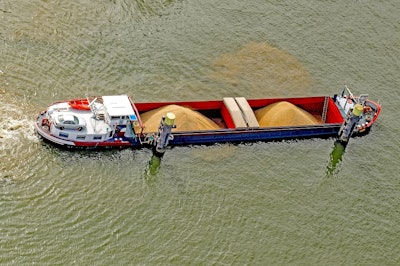
Low water levels have returned to the Mississippi River System just as the harvest season ramps up, threatening to complicate the transportation of what's projected to be a record corn crop, according to the Grain Transportation Report from the U.S. Department of Agriculture's Agricultural Marketing Service.
Following an exceptionally dry August — the driest on record for the Ohio Valley — water levels have fallen dramatically throughout the river system. The Ohio River, which typically contributes about 50 percent of the lower Mississippi River's water flow, is currently providing just 12 percent, according to the September 25 Grain Transportation Report.
"Currently, where the Ohio River converges with the Mississippi River, the Ohio River gauge at Cairo, IL, is at 10.7 feet—just above the low water threshold," the report noted. Further downstream, the gauge at Memphis, Tennessee, measures -7.1 feet, while at St. Louis the gauge reads 1.4 feet, down from over 23 feet at the start of August.
In response to the deteriorating conditions, the U.S. Coast Guard implemented draft and tow size restrictions on September 19. Southbound traffic between Cairo and Lake Providence, Louisiana, cannot exceed 10 feet in draft, while tows are limited to no more than six barges wide.
Simultaneously, the U.S. Army Corps of Engineers has undertaken multiple dredging operations throughout the river system, temporarily restricting navigation in some areas. The vessel Jadwin dredged sections near Memphis in mid-September, and the Goetz is currently dredging near St. Louis, with work expected to continue until October 2.
Despite these challenges, barge freight rates haven't risen to the levels seen during previous drought periods. As of September 23, the rate for shipping grain along the lower Mississippi River from Cairo to Memphis is $19.53 per ton — up 31 percent over the past month but 14 percent lower than the same time last year and 31 percent below the three-year average.
The report attributes this moderation in rates partly to improved preparation by government agencies and industry following the severe disruptions of 2022, when rates reached a record $105.85 per ton at St. Louis in October.
Another factor keeping rates in check is the projected decrease in soybean exports. While corn exports are forecast to reach a record 75.6 million metric tons in marketing year 2025/26 — supported by year-to-date sales 46 percent above the five-year average — soybean export sales have fallen 54 percent below average, largely because China has yet to make any purchases for the new marketing year.
"Below average soybean exports may keep barge rates from rising substantially. However, the large volumes of corn exports and the potential for trade deals involving soybeans may raise the demand for barge transportation in the coming months," the report concluded.
With NOAA's 6-10 day precipitation outlook showing below-average rainfall for much of the Ohio River basin, navigation challenges could persist well into the harvest season.















